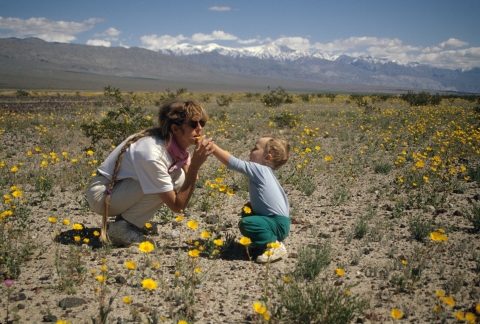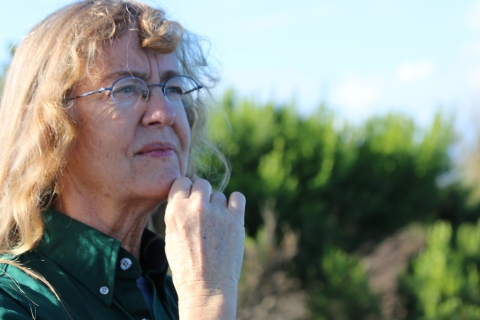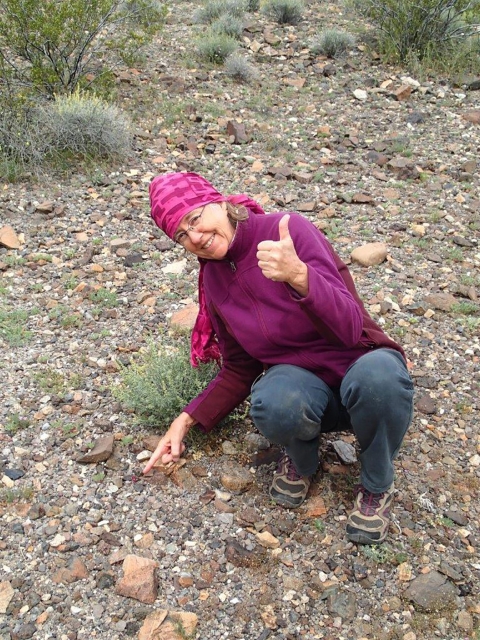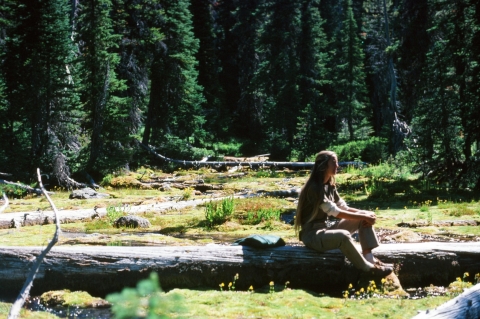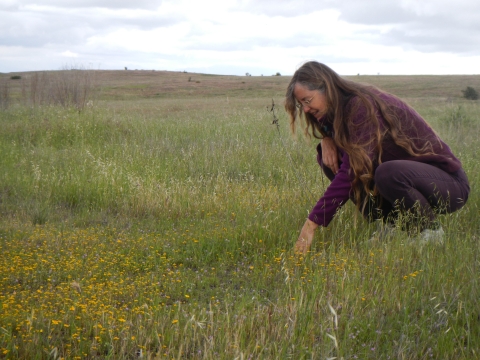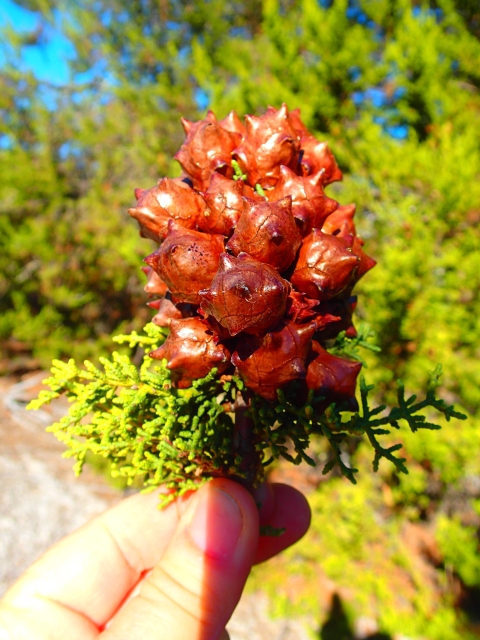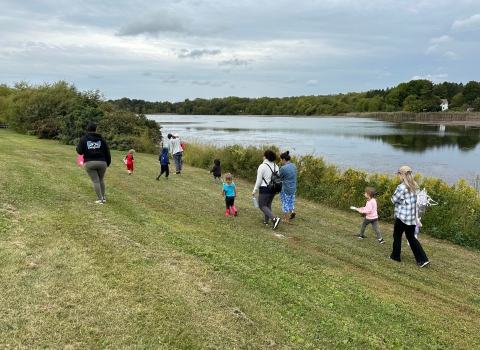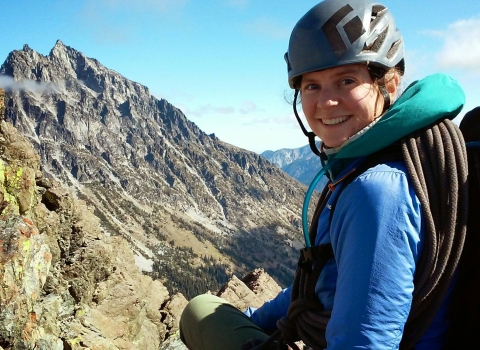Santa Cruz cypress, Lane Mountain milk-vetch, and Island bedstraw. Few people know them by name, but we can attribute their continued existence on Earth, in part, to one woman’s passion and lifelong commitment to their recovery. As we celebrate inspirational women in science during Women’s History Month this March, we delve into the inspirational life and career of U.S. Fish and Wildlife Service botanist Connie Rutherford, and the plants she helped save from the brink of extinction.
“This is much more than just a job for her,” said Ray Bransfield, Rutherford’s husband of 27 years.
“I remember Connie and our son sitting on their haunches in the middle of a field of wildflowers in the Panamint Valley.” It was 1998, a banner year for wildflowers. Bransfield describes a moment captured on film that epitomizes his wife’s love of wild places and natural landscapes, a love she nurtured traveling the world as a diplomat’s daughter and lifelong adventurer. Bransfield and Rutherford passed on their love of the outdoors to their children, Tyler and Terra.
Rutherford’s own childhood was spent overseas in Venezuela, Iran, Canada, and Indonesia, impressing upon her at an early age the stark contrasts between urban and natural landscapes. Her family settled in California when she was an adolescent and she recalls sleeping on the roof of her parents’ house in Long Beach “to get away from the TV, the noise, to just look at the stars.”
Rutherford cut short her travels around Europe during a break from college in Santa Cruz to take an introductory botany class at the University of California, Davis, in 1973.
“I had never taken a science class before,” she admitted. She could hardly contain her excitement as she recalls the pivotal moment more than 45 years ago, when she fell in love with the world of plants.
“We learned about photosynthesis. I was mind blown,” she exclaimed. ”How miraculous is it that plants can take carbon dioxide, water, soil, and sunlight, and through this remarkable process of photosynthesis, make oxygen and carbohydrates for all the rest of life on earth to live and eat!”
Rutherford credits her mother with the adventurous spirit that led her to become a firefighter in Olympic National Forest, then a backcountry ranger in Rogue River National Forest, and later a natural resource surveyor in the Alaskan tundra. “My mother was a trailblazer, a pull-yourself-up-by-your-bootstraps, self-made woman. She left home at 17, learned to fly, and became a decoder for the U.S. Department of State,” she said. “She had a willingness to go off into the unknown, and taught me to leave myself open to the learning experiences that the world has to offer.”
Graduating with a Bachelor of Arts degree in plant sciences from the University of California, Santa Cruz in 1975, Rutherford went on to pursue her master’s degree at Humboldt State University with the encouragement of Dutch ecologist Rudi Becking. “Rudi is no longer with us, but I will forever be grateful to him for encouraging me to pursue this path,” she said. Her advisor John Sawyer, was another influential person during her studies of plant communities in the Sky Lakes Basin of the Cascade Mountains in Oregon. “Standing on a peak with him overlooking the lake basins, I was in awe over how he could read the landscape,” she said.
Rutherford feels that our society turns a blind eye to plants’ contributions to our world.
"Show a person a picture of a lion in a tree. What do people see? They see the lion,” she said. “But people don’t realize the tree is the anchor of the ecosystem, providing shelter and food for all of the wildlife that uses that landscape.”
The experienced botanist admits she is often asked the question, “But why do plants really matter?” For her, the answer is simple: we, and the rest of life on earth, need them to survive.
“Plants are working so hard for us, keeping our watersheds intact, pumping out oxygen, keeping our pollinators around so we can have agriculture,” she said. “They are critical to the whole web of life.”
Rutherford saw that first hand as a Peace Corps volunteer in Haiti from 1985 to 1987. At the time, Haiti had already lost 95 percent of its forests due to agriculture and other land uses. Communities faced extensive soil erosion and the waters surrounding the country were clogged with sediment from agricultural run-off. Rutherford worked alongside the Food and Agriculture Organization, a branch of the United Nations, to help villagers set up tree nurseries in their backyards to replenish the soil, thus allowing them to continue their food crops of beans and corn, while stabilizing the small plots of land on which families farmed and lived.
She returned to California after two years with the Peace Corps in Haiti. “I realized that we have a better chance to conserve our wild landscapes, and I knew I had to be part of that effort.”
The next three decades, Rutherford worked to recover some of the many species of rare plants in southern and central California, some of which teetered on the edge of extinction in the 1980s due to habitat loss and fragmentation from urban expansion, agricultural conversion, and recreation.
In 1990, the U.S. Fish and Wildlife Service was petitioned to list over 100 plant species in Southern California under the Endangered Species Act. Rutherford, a botanist for Bureau of Land Management at the time, was hired on at the U.S. Fish and Wildlife Service to analyze their status based on the best available science, ultimately leading to Endangered Species Act protections.
Rutherford’s work, along with her co-worker Tim Thomas, led to the protection of 13 plant species on the northern Channel Islands; from the Santa Rosa Island manzanita to the Santa Cruz Island fringepod. She and her colleague worked with the National Park Service and U.S. Geological Survey to develop a conservation strategy for those species. The strategy outlined what the plants needed to recover, set goals to reduce threats, and helped guide management of the islands.
“That really helped turn the situation around for those ecosystems on the Channel Islands,” she said. Over time, ranching and hunting were phased out, allowing native plants like the island bedstraw to spread back into their historical habitat. “Grazing pushed the plants to only survive on cliff edges, but once the grazing came to an end, the plants had a chance to repopulate.”
She also worked with natural resource professionals from the Department of Defense at Fort Irwin National Training Center, California, and BLM to study in depth the Lane Mountain milk-vetch, a species that only exists in the Mojave Desert. The plant, once thought extinct, was rediscovered in 1985. Rutherford and her husband spotted a new population of the plant a few years later, and she returns every spring to conduct surveys with natural resources staff from Fort Irwin and BLM. She suggests that the more we learn about rare plant species, the better chance we have at recovering them and conserving the ecosystems in which they live and thrive.
“It’s like squares in a quilt that are stitched together,” she said. “If the threads start loosening, the squares start to detach, and the whole quilt eventually falls apart.”
Those stitches strengthened in Santa Cruz County when Rutherford and other conservationists celebrated the downlisting of the Santa Cruz cypress from endangered to threatened under the Endangered Species Act in 2015. The cypress, found in the Santa Cruz Mountains of San Mateo and Santa Cruz Counties, was listed as an endangered species in 1987 due to threats from logging, development, and agricultural conversion. Rutherford said the listing focused conservation resources on recovery planning and projects in partnership with the California Department of Fish and Wildlife, California Department of Parks and Recreation, San Mateo County, and conservation efforts by private landowners in Santa Cruz County.
“We chipped away over the years to address issues like habitat protection. We worked to understand the ecology of the species – especially its response to wildfire - and established seed collections,” she said.
The number of known trees in 1987 was 2,300. Today, improved data indicates some 33,000 to 44,000.
“I think one of the things that’s so remarkable about Connie is how she works with people,” said Bransfield, a wildlife biologist for the U.S. Fish and Wildlife Service (they met on the job), who has observed his wife’s knack for networking and building partnerships that have helped contribute to the recovery of listed plant species like the Santa Cruz cypress.
Rutherford has mobilized universities, land managers, non-governmental organizations, and research institutions across southern and central California to support rare plant conservation.
With three other female botanists, she established Botswap, a forum for dialogue across the botanical community to share information and resources along the central coast region. “We need to have that dialogue,” she said. “We need to make sure we have the best information to help us reach our goals, while at the same time putting a name and a face on our agency.”
Botswap has since been replaced by another collaborative group, headed by the Land Conservancy of San Luis Obispo County that is focusing on conserving unique dune habitats and their constituent species, including Nipomo lupine. After years of securing support for research on the species, Rutherford is heartened to see that the combined efforts of the Land Conservancy, the University of California Santa Barbara, and the Santa Barbara Botanic Garden may have finally turned a corner and put this plant back on the road to recovery.
Rutherford has also served in numerous leadership roles over 28 years with the California Native Plant Society, a large network of partners from academics to non-profits dedicated to plant conservation. She is currently working on a committee to promote a certification program for professional botanists in California.
“Connie's decades-long, active engagement with the plant research and conservation community enables her to collaborate with species experts to address questions that contribute to conservation of our listed plants,” said Cat Darst, Rutherford’s supervisor and Assistant Field Supervisor for the U.S. Fish and Wildlife Service in Ventura. “These relationships are critical to help our partners recognize what steps are needed to recover our listed plant species.”
When asked what advice she would give to budding botanists, Rutherford said, “If you have the opportunity to get out and work in the world, volunteer, take on internships, see different parts of the country, the world, do it! Learn how land-use planning works, how laws and regulations work, and learn how to communicate and work with all different types of people. “And don’t be afraid to ask questions. Seek out mentors in your field. Seek out people who have spent their lives studying what interests you. Those experiences and that knowledge are irreplaceable.”
As for the future of plant conservation, Rutherford said there’s one thing that we need to work toward. “As a society, we’ve decided that conservation of our natural resources is a value that we uphold. There’s education that needs to continue to take place, so that our kids don’t only see the lion, but they also see the tree.”

